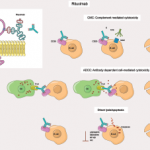SAN DIEGO—In their study, Effect of Trimethoprim Sulfamethoxazole Prophylaxis on Infections During Treatment of Granulomatosis with Polyangiitis with Rituximab: A Population-Based Study, Mendel et al. assessed the relationship between trimethoprim sulfamethoxazole (TMP-SMX) and infection in patients undergoing treatment for granulomatosis with polyangiitis (GPA).
Background/Purpose
Infections during treatment of anti-neutrophil cytoplasmic antibody (ANCA) associated vasculitis (AAV) lead to excess mortality. Trimethoprim sulfamethoxazole, recommended for pneumocystis jirovecii pneumonia prophylaxis, has broad antimicrobial activity. Mendel et al. assessed associations between TMP-SMX prophylaxis and subsequent infections within a U.S, population sample of patients with granulomatosis with polyangiitis (GPA) treated with rituximab.
Methods
Mendel et al. included adults with GPA within the Merative Marketscan Research Databases who had a minimum six months of insurance enrollment prior to a first (index) treatment of rituximab (2011–20). Baseline TMP-SMX prophylaxis was defined as a ≥28-day prescription dispensed within 30 days (before/after) initiation of rituximab. The researchers defined serious infections as a primary inpatient ICD-9 or 10 diagnostic code for infection following the index date (excluding viral and mycobacterial codes). Secondary outcomes were outpatient infections (for the same codes) and pneumocystis jirovecii pneumonia. Subjects were followed until end of insurance enrollment or Dec 31, 2020. Multivariable Cox proportional hazards regression assessed the association of baseline and time-dependent TMP-SMX with serious infection. Models were adjusted for age, sex, prednisone (≥20 mg/day dispensed fewer than 30 days prior to index rituximab), hospitalization and/or serious infection in the six months prior to index rituximab, and having any of of the following: interstitial or obstructive lung disease, diabetes, chronic kidney disease or dialysis.
As a sensitivity analysis, the researchers assessed the association between TMP-SMX prophylaxis and a control infection, herpes zoster (HZ).
Finally, the researchers determined rates of adverse events potentially attributable to TMP-SMX during person-time exposed and unexposed to TMP-SMX.
Results
The cohort included 919 individuals with GPA—mean age 52 years (SD 16)—who were treated with rituximab. Fifty-three percent were women. TMP-SMX was dispensed to 281 (31%) at the time of the index rituximab (and to 40% on prednisone ≥20 mg/day). Over a median (IQR) follow-up of 496 (138,979) days, the rates of serious infection, outpatient infection and PJP per 100-person years were 6.1 (95% confidence interval, CI 5-7), 28.7 (95% CI 26–32), and 0.7 (0.4–1.2), respectively. Serious infections were primarily pulmonary (36%) or general sepsis (45%). In multivariable analyses, TMP-SMX was negatively associated with serious infections, considering baseline (adjusted HR 0.5; 95% CI 0.3–0.8) and time-varying TMP-SMX exposure (aHR 0.5; 95% CI 0.3–0.9). Prophylaxis was also negatively associated with outpatient infections (aHR 0.7; 95% CI 0.5–0.9). Thirteen pneumocystis jirovecii pneumonia infections occurred, all in subjects who were not exposed to TMP-SMX. TMP-SMX was not associated with reduced HZ (aHR; 1.6, 95% CI 0.6–3.2). Rates for adverse events potentially attributable to TMP-SMX per 100 person-years were 29.6 (95% CI, 22–39) during periods of TMP-SMX exposure and 13.4 (95% CI, 11–16) during periods without TMP-SMX exposure.



